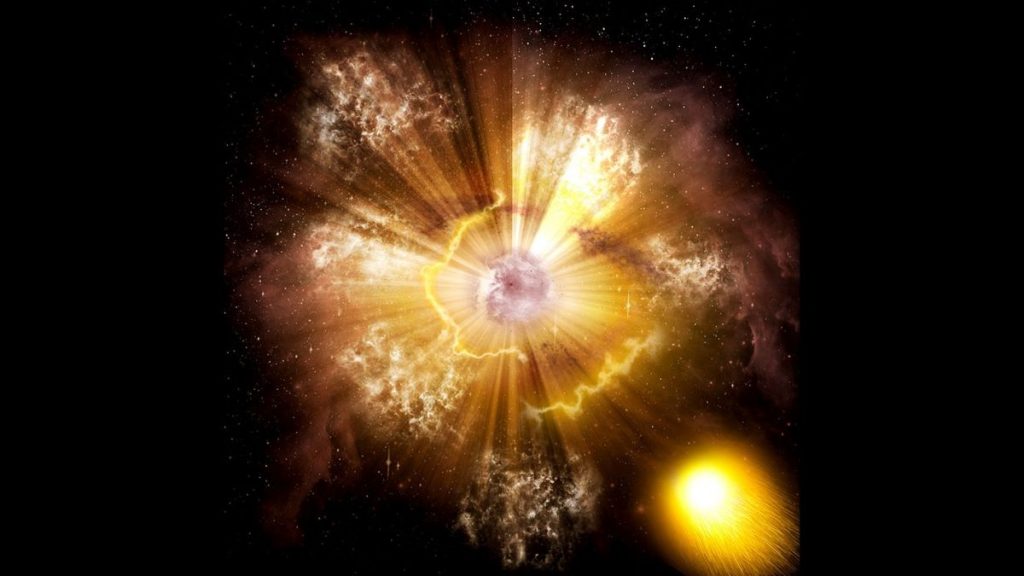
Mysterious high-speed gas cloud might be the result of an explosive stellar death (Image Credit: Space.com)
A mysterious, ultrafast cloud may be the result of the explosive stellar death that birthed a neutron star 100,000 years ago and around 532 light-years away, new research reveals.
High-velocity clouds (HVCs) are concentrations of hydrogen gas that often dwell in large complexes. They are remarkable because of their incredible velocities, which don’t fit within the regular rotation speed of the Milky Way. The new research may provide insight into the origins of HVCs, which have puzzled scientists for decades.
“Distance is the clue to understanding HVCs,” Joan Schmelz, an astronomer at the Universities Space Research Association and lead author of the research, said in a statement (opens in new tab). “Many of the mysteries would be solved if we just knew how far away they are.”
Related: 1st maps of massive, translucent gas clouds in space reveal clues about the early universe
Focusing on an HVC named “MI,” Schmelz and colleagues discovered an evacuated cavity within the HVC’s structure. This cavity could have been cleared by a supernova, the massive explosion created when a star dies.
Near the center of the cavity in MI is the giant star 56 Ursae Majoris, which is part of a binary system with another difficult-to-see star. This second compact object is now known to be a neutron star — an ultradense stellar remnant created when a large star reaches the end of its life and explodes in a supernova. Therefore, this supernova could have kicked the HVC called MI into high gear, the research team said.
Thus far, supernovas have been mostly considered incapable of providing the kick needed to propel HVCs to their observed speeds. However, MI may be one of a family of close HVCs that are exceptions to this.
Could supernovas kick HVCs into high gear?
Many models place HVCs in the halo region of the Milky Way, away from our galaxy’s spiral arms and central bulge and many thousands of light-years from the sun.
At these vast distances, larger HVC complexes could contain masses of star-forming gas equivalent to millions of times the mass of the sun. This would make these complexes major sites of star formation and thus key players in galactic evolution.
Other possible origins of HVC complexes have been suggested, including the idea that the Milky Way may have ripped them out of other galaxies, or that our galaxy ejected its own HVCs that are now gradually falling back toward it.
Until now, many scientists have rejected older supernovas as HVC sources, as they didn’t appear to have enough energy to launch massive HVCs at their observed velocities. However, this is only the case with the HVCs located at tremendous distances.
If HVCs are closer, or at least some of them are, supernovas could be a factor in HVCs’ origins. MI is close to us, at least in astronomical terms, and the mass and energy of this HVC are easily in line with what is expected from a supernova.
“Ironically, this scenario for MI only came together because we were exploring low-velocity gas in the direction of high-velocity clouds,” said Gerrit Verschuur, an HVC expert and co-author of the research, said in the statement. “If this supernova model is correct, it gives us a definitive distance to MI.”
Thus far, the team has investigated this scenario for just this one MI, and this was possible only because the supernova that marked the creation of this neutron star left its companion,56 Ursae Majoris, intact.
That means the Milky Way could be replete with many similar stellar remnants that have gas features with remarkable velocities but that lack a bright companion star to aid in their identification. As such, the origins of HVCs are likely to remain a subject of intense debate for astronomers; MI may become one of the only objects of this kind to have a definitive history and well-defined distance attributed to it.
The team’s research is set to be published in The Astrophysical Journal.
Follow us on Twitter @Spacedotcom and on Facebook.





